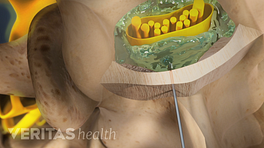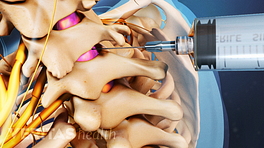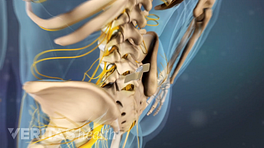A cervical epidural steroid injection may be performed to relieve pain associated with inflammation around the nerves in the neck.
The epidural space surrounds the dura. The dura is the sac around the nerve roots that contains cerebrospinal fluid and spinal cord and nerves. The nerves in the neck travel through the cervical epidural space before extending down through the shoulders and into the arms and hands.
An injection into this space delivers medication directly to coat the nerves in the area. A number of cervical spine conditions can affect the nerves as they exit the spine through small holes on each side of the vertebrae.
A cervical epidural injection may be used to treat the symptoms from a variety of conditions that may irritate the cervical nerve roots. For example, a cervical herniated disc may impinge on a nerve root, a degenerated disc may cause local inflammation, cervical osteoarthritis or spinal stenosis may reduce the space for the nerves, resulting in inflammation and irritation to the nerves.
With a cervical epidural injection, the procedure is performed with the patient laying face down. An area of skin and tissue above the injection site is injected with a local anesthetic to numb the area. Next, a larger needle is inserted.
X-ray guidance, called fluoroscopy, is used so the practitioner can visualize the needle going into the cervical epidural space. Contrast dye is injected into the space to make sure the needle is properly positioned in the epidural space near the irritated nerve or nerves. A cortisone steroid solution is injected into the epidural space. The steroid is an anti-inflammatory medication. The goal is to alleviate the local inflammation, which in turn should decrease the associated nerve pain.
A cervical epidural injection is often done with the goal of providing enough pain relief so that the patient can progress with a rehabilitation program.









